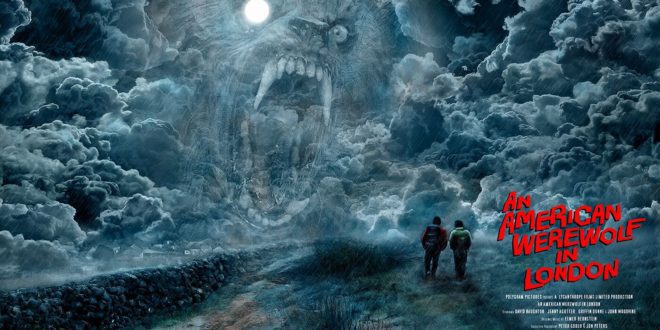Writer/director John Landis’ An American Werewolf in London was released forty years ago on August 21, 1981, and it is inarguably the greatest werewolf movie of all time. I’d also say it’s one of the best horror films of the ‘80s, a decade that’s absolutely saturated with genre classics. Notably, the massively impressive practical effects are so good that they won the first ever Oscar for Best Makeup. Landing genuine bits of comedy amongst shocking horror is never an easy feat, but Landis walks a tonal tightrope and delivers my favorite film of his oeuvre.
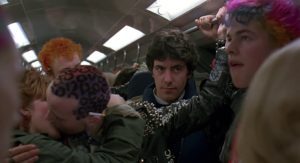
David (David Naughton: Ice Cream Man 1995) and his best friend, Jack (Griffin Dunne: After Hours 1985), are college-aged guys backpacking across the rolling countryside of northern England. Wanting to get in out of the cold, they receive a frosty welcome at a small village pub ominously named The Slaughtered Lamb. Before unceremoniously taking their leave of the insular community, they’re warned to keep to the road, stay off the moors, and to beware the moon. As it starts to rain, the pair loses their way and is eventually attacked by some sort of large beast that kills Jack. David is seriously wounded and only survives because of the intervention of some villagers having a bout of conscience.
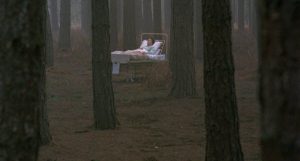
Waking up in London, David is nursed back to health by Dr. Hirsch (John Woodvine: The Devils 1971). The traumatized young man also has instant chemistry with his nurse, Alex (Jenny Agutter: Child’s Play 2 1990). Plagued by increasingly horrific nightmares, David begins receiving visitations from Jack’s gruesome ghost. Jack warns David that he’s been cursed to become a werewolf and that he must kill himself before he transforms. David isn’t sure if he’s losing his mind but when the full moon rises, he becomes a monster and rampages across the city.
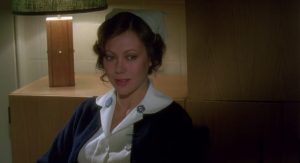
Landis’ script for An American Werewolf in London is both efficient and clever. The comedic moments are used sparingly but they feel organic, using David’s fish out of water situation to elicit chuckles while also subtly referencing his Jewishness. This “otherness” is also a subtext of the film, with bits of dialogue and a horrific dream sequence referencing Nazis emphasizing the motif. The depiction of David and Alex’s romance maybe feels a little rushed, but this is an extremely minor nitpick.
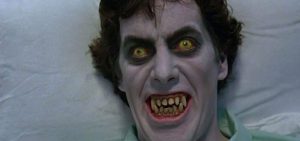
Naughton and Agutter work well together, though, as her affection for the charismatic American gives An American Werewolf In London some of its tragic weight. Dunne does nice work, especially as he’s increasingly slathered in gory corpse makeup. Watch for Yoda himself, Frank Oz, in a cameo as an exasperated employee of the US embassy, British comedian Rik Mayall (Shock Treatment 1981) as a patron at The Slaughtered Lamb, and Alan Ford, who would go on to play menacing crime lord Brick Top years later in Guy Ritchie’s Snatch (2000).
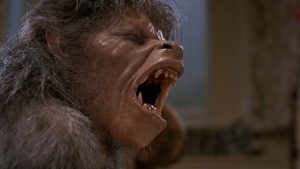
In only 97 minutes, Landis is able to conjure a fatalistic mood while still propelling the narrative forward. The horror sequences are breathtakingly cool, with Landis expertly using shock, gore, and tension in varying fashions. DP Robert Paynter (Little Shop of Horrors 1986 – read our 30th anniversary appreciation here) shoots the hell out of the subway stalking section and the verite-inflected climax. The location shooting also brings a grounded realism to the fantastical proceedings. In particular I’m thinking of the stark beauty of rural Wales (doubling for rural England) and the panic-filled chaos at famous Piccadilly Circus.
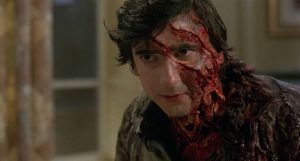
Landis injects some wry irony into the An American Werewolf In London proceedings with his lunar-based poppy soundtrack, as well. We get “Blue Moon,” “Moondance,” and “Bad Moon Rising,” amongst others. This approach contrasts nicely with the more traditional and classy score by Elmer Bernstein (Ghostbusters 1984). I’d also be remiss if I didn’t mention the excellent sound effects work. The werewolf’s howls and growls invoke an otherworldly ferocity that is truly eerie and primal.

All of these elements make for a very well crafted and entertaining flick, but the legendary Rick Baker’s effects work sends An American Werewolf in London into the stratosphere. From the gooey but expressive work on Jack to the bizarre Nazi creatures of David’s nightmare to the intimidating werewolf work, Baker (Videodrome 1983) and his team nail everything. Of course, the iconic transformation scene is a singular piece of work, which Landis wisely lingers on. That it is still impressive today is a testament to Baker’s god-tier skills. It should also be said that the editing by Malcolm Campbell (Scary Movie 3 2003) here and in the Piccadilly Circus climax makes clear sense of confusion and chaos, allowing viewers the full pleasures of craft, mood, and narrative.

I absolutely love John Landis’ An American Werewolf in London. It’s thrilling, funny, shocking, tragic, well-made, and thematically interesting, and it holds up all these decades later. Pretty much every component works together in harmony to deliver a fantastic film. If you like horror at all and have an appreciation for practical effects work but you’ve never seen this, drop what you’re doing and find somewhere to watch this right now. Highest possible recommendation.
 PopHorror Let's Get Scared
PopHorror Let's Get Scared
